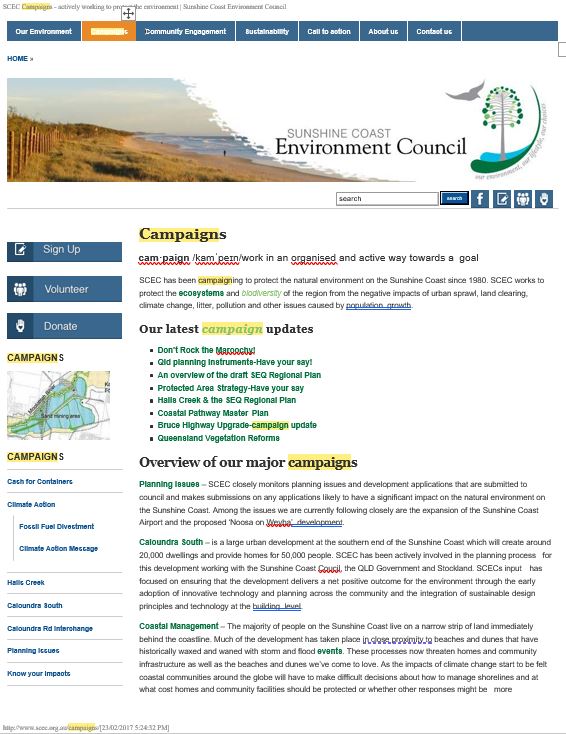Caloundra South is a large urban development at the southern end of the Sunshine Coast which will create around 20,000 dwellings and provide homes for 50,000 people within a stones throw of the internationally significant Pumicestone Passage Wetlands. SCEC has been campaiging to secure conditions that will provide the greatest possible environmental protection throughout the life of this development. Issues of particular concern include: storm water quality, sediment erosion, survival of wallum frog population, revegetation, creeks and riparian areas, fauna crossings. The latest news on this campaign:
– Free seminar calls community to action on planning laws
– Media Release: Pumicestone Passage sacrificed by State Government
– Caloundra South Submissions
Environmental Issues at Caloundra South
The site was first identified as a future urban growth area by the Caloundra City Council who envisaged a target population of between 10 and 20 thousand people. The site was included in the first SEQ Regional Plan (2006) with a target population of 40 to 50 thousand people. After the amalgamation process of 2008 planning for the development became the responsibility of the Sunshine Coast Council. In October 2010 the State Government seized planning control for the area from the Sunshine Coast Council and handed it to the Urban Land Development Authority (ULDA) who released their development scheme in October 2011.
The land is wholly owned by Stockland who have prepared a master plan for the area which was submitted to the ULDA and approved in June 2012. Before Stockland can commence development on the site it will need to receive Federal Approval under the Environment Protection and Biodiversity Conservation (EPBC) Act to ensure the development does not negatively impact on matters of national environmental significance. It has prepared a Public Environment Report (PER) detailing the expected impacts from the development and the proposed responses to avoid or minimise these impacts. The PER is open for public comment between 12 November 2012 and 14 December 2012 and is the last statutory opportunity for the community to raise concerns about the environmental impacts of the development.
SCEC has been actively involved in the planning process for many years, working with the local council, state government and directly with Stockland to ensure that if the development proceeds it has a NET POSITIVE impact on the environment and deliver a best practice community that uses the best available sustainable design and technology in all facets of the development (from build form to infrastructure and from transport to revegetation). Our engagement has focused predominantly on the following key concerns:
– Water Quality & Flow – The development will significantly alter storm water flows across the site taking nutrients from a newly urbanised area into Lamerough Creek and Bells Creek and on into the Pumicestone Passage (an internationally significant Ramsar Wetland). Water running of the site should meet water quality standards that will aid the recovery of the Pumicestone Passage and should maintain a flood regime that is consistent with historical flooding of environmentally significant areas on and adjacent to the site. Click here for more details about water quality.
– EP Zone & Corridors – The development scheme and master plan make provisions for the revegetation of an environmental protectionzone (400 ha) and biodiversity corridors along the creeks that run through the site. The revegetation of these areas should be undertaken as a matter of priority and key stages in the development should be made contingent on the delivery of expected outcomes for the revegetation process. Corridors should actually link the newly revegetated conservation area with existing habitat areas to the North, East and West of the side and should make provisions for save fauna movement throughout the site and across the Bruce Highway. Click here for more details about biodiversity.
– Sustainable Design & Technology – The development should deliver buildings (domestic, commercial and industrial) and infrastructure that incorporate the best available sustainable design and technology. Given that delivery of the development will take 30 years or more provisions should be made for ongoing monitoring of innovation and strategies should be in place to ensure that the design and technology that is being used is reviewed and updated at each subsequent stage of the development.
– Monitoring & Reporting – Clear provisions need to be made for the ongoing monitoring and reporting of actual environmental impacts with approvals for future stages being made contingent on the achievement of environmental benchmarks.
SCEC is in the process of reviewing the PER documents and we will publish a summary of our findings when we have completed this process to support people who want to make a submission to the PER process (expected late November 2012). We will also publish a submission pro-forma for people wanting to support our submission. SCEC is in discussion with Stockland about engagement on environmental matters relating to the development post the PER process.

